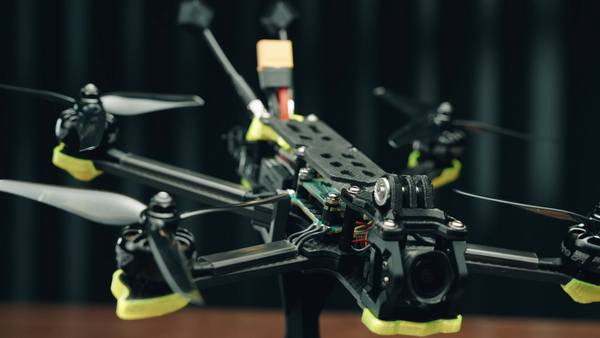In a groundbreaking fusion of technology and speed, drone aficionados have pushed the boundaries of DIY engineering, crafting the first FPV filming drone capable of shadowing an F1 car at full tilt around a race track. This narrative dives into the journey of Ralph Hogenbirk (better known by his alias, Shaggy) and the Dutch Drone Gods team, detailing the inception, challenges, and technical wizardry behind this unparalleled achievement.
Genesis of a High-Speed Pursuit
A decade ago, at the youthful age of 25, Hogenbirk's foray into drones began as a mere hobby. Yet, as drone technology evolved, so did Hogenbirk's involvement, transitioning from hobbyist builds to competing in the Drone Racing League, and eventually capturing the essence of high-speed events like the Red Bull Valparaíso Cerro Abajo in 2020. The pinnacle of this journey? A custom-built FPV (first-person view) drone designed to pace with the velocity and agility of Red Bull's RB20 F1 car around the legendary Silverstone Circuit.
Engineering Challenges
Crafting a drone that could match an F1 car's acceleration, navigate tight corners, and endure the entirety of a 5.8km lap without combusting presented an array of engineering puzzles. The quest to build such a marvel began with a call from Red Bull, proposing a concept that seemed as daunting as it was thrilling: a drone that could follow an F1 car for an entire lap, not just in straightaways but through the demanding turns as well.

Design Philosophies and Inspirations
The team embarked on a meticulous design process, prioritizing aerodynamics over mere weight reduction, aiming for efficiency and endurance. This approach diverged from previous attempts that focused on speed, which involved lightweight designs with limited battery capacity and no filming capabilities. The team knew that achieving high speed was feasible, but incorporating filming equipment and maintaining stability in corners required innovative thinking.
Technical Ingenuity
The drone's hardware amalgamated standard components with cutting-edge, unreleased parts from suppliers, pushing the limits of RPM and efficiency. The structure, a product of rigorous 3D printing and carbon CNC techniques, was a testament to the team's commitment to precision and innovation. Achieving a top speed of 350 kph, with acceleration rivalling that of F1 cars, the drone marked a significant milestone in both drone and F1 history.

The Fusion of Speed and Technology
With capabilities like 4k60fps / 5k30fps camera quality and aspirations for live streaming, the drone not only showcases technological prowess but also promises to revolutionize the viewing experience of motor sports, offering unprecedented perspectives of the racing world.

Building Your High-Speed Camera Drone: Basics and Parts List
Creating your own high-speed camera drone is a thrilling project that combines the adrenaline of racing drones with the beauty of aerial photography. If you're inspired by the design of the XLR V3 FPV drone and want to capture onboard footage, here’s a streamlined guide to get you started, focusing on the basic considerations for parts selection and the complete parts list.
Complete Parts List
- Frame: Custom Design/3D Printed, inspired by XLR V3
- Battery: Tattu R-Line 6S LiPo (Consider using two 6S 1300mAh cells in parallel for extended flight time)
- ESCs: Spedix GS35A
- Motors: Cobra 2207 2450kv
- Vtx: HGLRC Zeus 800mW
- Flight Controller: HGLRC Zeus F722 mini
- Radio Rx: Happymodel ELRS EP1 2.4GHz
- FPV Camera: Caddx Ant
- Props: APC 5.2×6.0



Adding a Recording Camera
- Naked GoPro: Ideal for lightweight, high-quality video recording. Ensure it’s powered correctly and securely mounted.
- DJI O3 Air Unit (Naked): For those preferring DJI's ecosystem, stripping down an O3 Air Unit for weight savings while maintaining high-quality transmission and recording.




Parts Selection Basics
Frame
Your drone's frame is the backbone of the build. For high-speed applications, you want a frame that's lightweight yet durable enough to withstand the rigors of high-speed flight. Although the frame for this project will need to be custom-designed or 3D printed, drawing inspiration from the XLR V3 design is a good start.
Power System
Choosing the right battery and motors is crucial for balancing speed with flight time. A high-voltage battery (6S LiPo) paired with efficient, high-kV motors will give you the thrust needed for high speeds.
Electronics
Your flight controller and ESCs should be capable of handling the high power output and providing the necessary control precision for fast flights. Additionally, a reliable video transmitter (VTx) and FPV camera are essential for real-time flight feedback.
The seamless fusion of speed, technology, and creativity has not only shattered preconceived limitations but also opened the gates to new possibilities in the realm of sports broadcasting and beyond. The drone's ability to capture the high-speed thrill of an F1 race from an unprecedented perspective promises to revolutionize the way we experience and interact with fast-paced sporting events, offering viewers a bird's eye view that's as exhilarating as being in the driver's seat.
For the aspiring drone builders and enthusiasts inspired by this pioneering project, the path has been illuminated. With the basic guide and complete parts list provided, the opportunity to build your own high-speed camera drone is within reach. This endeavor, while challenging, invites you to step into the world of custom drone creation, where innovation meets adrenaline.







